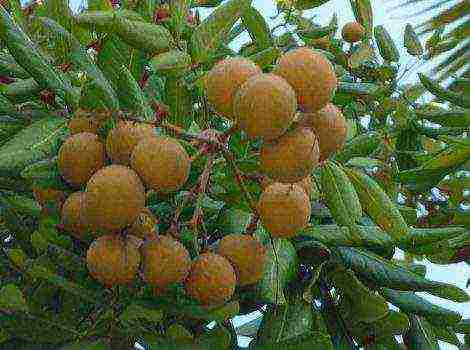Content
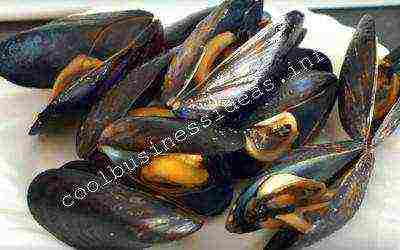
Mussel meat is a dietary and gourmet product at an affordable price. Now it is in great demand, so mussel breeding is a business with huge profitable potential, especially with the complete processing of products. A mussel farm begins to make a profit in the second year of operation and quickly pays off. This is a great option for
business at sea
.
The content of the article:
- What are the types of mussels?
- Breeding technology
- Financial investments and profitability calculation
- Breeding other aquatic animals
The case for a mussel (or mytilid) business:
- a significant length of the coastline of Russia with favorable conditions for breeding mussels, especially the Black Sea coast and the water area of the Azov Sea;
- the presence of a natural food base and planting material, which does not require additional costs;
- capital costs are necessary only when creating a farm, flow costs are minimal;
- continuity of production;
- the possibility of harvesting almost at any time "on order";
- the possibility of complete processing of products with minimal equipment costs;
- product demand exceeds supply.
What are the types of mussels? 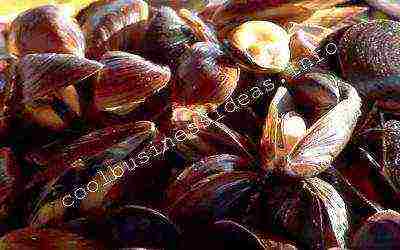
Optimal conditions for industrial breeding:
- Depth - 50-200 m;
- Temperature - 12-18 ° С;
- Nutrient algae biomass - 4-6 mg / l;
- Salinity of water - 17-34 ppm;
- The amount of oxygen is more than 80% of saturation.
The main species for breeding
1. Plain (or edible) - the most common type for cultivation. Spain, Holland, Russia, Italy, USA, China are engaged in their breeding.
Specifications:
- water temperature for development is 10 - 20 degrees;
- water salinity 16 - 32%, habitat depth - up to 60 meters;
- shell size up to 10 cm in length;
- breeds all year round;
- marketable size (5 - 8 cm) is achieved in 3 years.
2. Mediterranean distributed in the Mediterranean, Aegean, Marmara, Black, Azov, Japanese seas.
Specifications:
- the maximum shell size is 14 cm;
- habitat waters - sea, brackish;
- water temperature for development - up to 15 - 18 degrees;
- salinity of water - up to 18%;
- habitat depth - 1 - 20 m.
3. Korean. Distribution: Yellow Sea and Korean Sea
Specifications:
- marketable size (5 - 6 cm) is achieved in 2 years;
- habitat waters - sea;
- water temperature for development - up to 26 degrees;
- salinity of water - up to 30 - 34%;
- live at a depth of 40 m.
4. Pacific. They are caught in the Sea of Japan. Japan, Russia, North Korea are engaged in their breeding.
Specifications:
- commercial size (5 cm) is achieved in almost 2 years;
- habitat waters - northwest, northeast coast of the Pacific Ocean;
- water temperature for development - up to 9 - 18 degrees;
- salinity of water - up to 34%;
5. Gray mussel (or giant)
Specifications:
- Habitat - shallow waters of the Sea of Japan and Okhotsk;
- shell length - about 20 cm;
- the mass of the mollusk with a shell is up to 1.6 kg.
Breeding technology 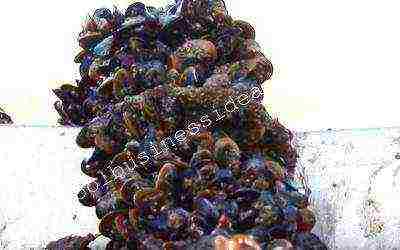
Growing mussels is considered a simple business, but it can only be done with access to the sea.
Several optimal breeding methods for mussels have been developed. Draw up a business plan based on them.
1. Raft growing
This is the most popular way. The rafts are fixed over the water with weights. The cargo is secured under the raft. A rope is suspended from it, the end of which has one more weight. Place at least 500 ropes on a 5x5 m raft. Place the raft at a shallow depth. Starting in April, mytilid larvae settle on top of the ropes and under normal conditions you will harvest about 45 tons of mussels per year from one raft.
2.Breeding on the ground
The easiest and most affordable way. Mytilid is collected from the ground with special dredges. One dredge accounts for about 450 kg of mussels. Cultivation takes place on the shallows, in a pre-prepared place. They equip plots for cultivation with the size of 200x500 m. Planting density - 7 kg / sq.m, grown for about 2 years. This method is popular in the Netherlands and Denmark.
3. Breeding by the "Boucher" method
The essence of the method is that in shallow water, where there are ebb and flow, logs 5 m high and 40 cm in diameter are driven into the sand. In April and May, mytilid larvae settle on the logs. The bottom of the logs is intertwined with tree branches to leave free. Mussels are removed from the logs starting in June, and then placed in special bags, which are attached to the logs, closer to the shore. There they are until they grow to marketable size.
This method has long been practiced in Europe, but it is more expensive.
4. Growing with cords
This method is inferior in popularity to the previous ones, but it is gaining momentum. It is very similar to the raft method. Only here the cords are not attached to the raft, but to the buoy.
Before starting a breeding business, contact the specialized institutes. They will be able to provide you with professional advice. Their services will not be expensive, but their help will be invaluable.
Mussels in the Black Sea
Financial investments and profitability calculation
The data of specialists from this field are as follows:
- The mussel plantation brings up to 500 tons of mytilids per year.
- The average cost of 1 kg of mussels is 250 rubles.
- The cost of the plantation (without installation) is about 40,000 rubles.
- Plantation installation - 600,000 rubles. (with boat rental and diving operations).
Business payback period - up to 3 years old.
Business profitability reaches - 20%.
It is possible to increase the profitability of the business due to the complete processing of mytilides, because they are used for the production of dietary supplements, crackers, mayonnaise, and artificial caviar.
But for such purposes, you will need capital in the amount of 1,400,000 rubles.
Breeding other aquatic animals 
1. We open an oyster farm in the Black Sea. A delicacy product that is in great demand, especially in resort towns. In addition, business investment will be minimal.
2. We breed fry. A simple and profitable way to make money without big investments. Due to the constant demand for this product, the costs pay off within 10-12 months.
3. We grow fish. This business does not need access to the sea. Just rent a reservoir (of which there are plenty in our country) and organize the cultivation.
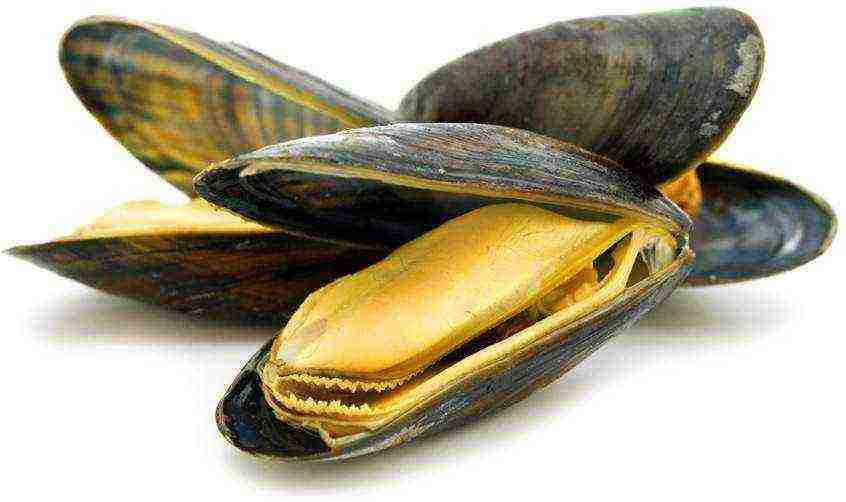 Seafood has always been very popular, but the demand for them has increased especially after it has become fashionable in modern society to take care of health and proper nutrition. From this point of view, shellfish meat is a very valuable product, the incredible benefits of which are quite comparable to its great taste.
Seafood has always been very popular, but the demand for them has increased especially after it has become fashionable in modern society to take care of health and proper nutrition. From this point of view, shellfish meat is a very valuable product, the incredible benefits of which are quite comparable to its great taste.
Baseline conditions
Breeding mussels at home in their natural environment is not possible everywhere. There are a number of requirements that must be met in order to ensure the normal functioning and reproduction of these mollusks. First of all, it is sea water, without which mussels are doomed to death.
In Russia, suitable conditions have developed on the southern coastline, in the waters of the Black and Azov Seas. According to the calculations of scientists, the natural resources of the Krasnodar Territory, for example, make it possible to organize the production of 20 thousand tons of mussels per year. This is less than the needs of the domestic Russian market, so even with 100% utilization of all available opportunities, demand will still exceed supply, which outlines an excellent prospect for the development of such a business.
It should be borne in mind that in Russia, the cultivation of mussels for commercial purposes is completely undeveloped. Given a fairly high demand, this niche is still free, so it is quite possible to occupy it even for small private farms.
Breeding technology in open waters
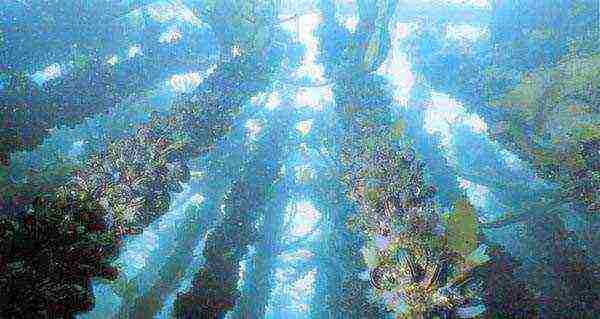 The technology for breeding mussels at home is quite simple, and therefore very effective. The main element is a collector, that is, a special mesh in which mussels are placed. Old seines can be used as a material for the manufacture of the collector, so that the cost of the necessary equipment is low.
The technology for breeding mussels at home is quite simple, and therefore very effective. The main element is a collector, that is, a special mesh in which mussels are placed. Old seines can be used as a material for the manufacture of the collector, so that the cost of the necessary equipment is low.
The collector is lowered under water, and in order not to be carried away by the current, it is fixed to a horizontal rope. One 100 m rope can accommodate 40 to 50 collectors, which constitutes a full-fledged plantation. The ideal depth for placing collectors is 4 meters.
Naturally, this is just a general scheme for breeding mussels. This is partly why it looks so simple. In fact, there are a huge number of nuances and subtleties in this issue, without which it is impossible to achieve good results. Therefore, before starting work on creating a farm for mussels, it is necessary to carefully study the theory of breeding mollusks.
For example, in autumn and spring, collectors with mussels must be transferred to an artificial reservoir, since in the open sea during this period, many different larvae are formed, which can kill mollusks.
Breeding technology in the aquarium
Breeding mussels at home can be established even in an area located far from the sea coast. In these cases, large containers are used to keep the shellfish. The best option is marine aquariums, which are sold today in a variety of configurations and volumes.
The minimum allowable volume for mussels is 100 liters. This aquarium is enough for the normal maintenance of 10-15 individuals. Required condition - regular filtration and aeration of water, as well as maintaining the temperature within 18-22 degrees Celsius... Mussels are cold-blooded animals, while they feel bad if the temperature of the environment rises more than 3 degrees above normal.
Also it is necessary to monitor the hardness of the water... In order for the mussel shell to retain its original qualities and fully protect the body of the mollusk, the calcium content in the water must meet certain standards. To maintain the desired concentration, pieces of chalk, shell rock, and refined limestone are added to the aquarium. If natural materials are not at hand, you can replace them with magnesium and potassium chloride.
When breeding mussels at home, special attention should be paid to nutrition. The most common reason for the lack of reproduction and even death of mollusks in captivity is their depletion. In nature, they feed on detritus, that is, organic residues, the reserves of which in seawater are replenished naturally. When keeping mussels in an aquarium, you will have to organize feeding the clams.
As a food base, egg yolk, crushed bread crumbs, pre-moistened dry fish food, as well as various microorganisms, which can be bought in specialized stores, where they are sold as food for marine animals, are used.
You need to feed the mussels every day. A mollusk with a body size of 4-5 cm requires approximately 30-40 g of feed. In this case, processed food is returned to the water in the form of phosphorus and nitrogen, and the mussels themselves do not tolerate high concentrations of these substances in the water. That's why you need to take care of additional cleaning of the aquarium with the help of special filters that free the water from phosphorus and nitrogen compounds.
Economic benefit
The main question that worries any businessman who is planning to launch a new project, and even such an unusual one as breeding mussels at home, is economic attractiveness, that is, the profit that can be obtained at the exit. Let's do some simple calculations.
One mussel is capable of producing about 10 thousand eggs per year, which by the beginning of the next season acquire a marketable size, that is, 4-6 cm.At the same time, one of the main advantages of such a business is that it does not require large expenses for the maintenance of plantations - mussels feed on their own, extracting nutrients from the water. Thanks to this, the cost of the meat obtained is significantly reduced.
Experience shows that from one medium-sized plantation, about 2 tons of mussels can be obtained per year. A medium-sized plantation is usually understood to mean 100 meters of rope with collectors evenly distributed along its length. The meat yield from each mussel is about 20-25%... That is, the mass of pure products is about 500 kg. The wholesale price of mussel meat depends on the season and the characteristics of the region, but on average it fluctuates around 100 rubles per kilogram.
Thus, the income can reach 45-50 thousand rubles. If you subtract from this amount overhead costs, wages and taxes, then the profitability of the business of breeding mussels at home will be quite high - within 60%.
Sales options
One of the main problems of any business related to the production of food is the sale of the resulting products. Mussels are rare gourmet goods, so sales opportunities should be sought in specialized catering establishments. These can be elite restaurants in which seafood is a specialty, as well as small cafes. Do not forget about the segment of frequent consumers who buy mussels for cooking in their home kitchen.
Special attention should be paid to the storage of products prepared for sale. Freezing or packing mussels in special vacuum containers extends the safe storage period of the goods several times. At the same time, processing increases the cost of the product.
Thus, it makes sense to think about purchasing the appropriate equipment. This will bring the home-based mussel farming business to a completely different level from all possible points of view: expanding opportunities for product sales, increasing profitability, etc.
Growing mussels is a business idea. How to grow mussels.
Mussel is one of the most popular marine bivalve mollusks in the world, it has a high nutritional value, the main advantages in cultivation are high fertility, ease of maintenance, mussels populate themselves on collectors, do not require additional feeding, they receive all the food (phytoplankton) themselves, during the filtration process sea water.
The technology of growing mussels in natural conditions is not complicated, it consists in installing special structures - collectors in places of their mass concentration.
.
.
The collector for mussels is also called a substrate, it can be of different designs, the simplest collector is a construction of a load, nylon rope with a diameter of about 10 mm with knots, with rope strands or plastic circles, alternating every 25 cm attached to the float.
The maximum number of mollusk larvae settles on the horizon 4 - 5 meters from the surface, respectively, usually the length of the collector does not exceed 5 meters. The collectors are fastened with ropes half a meter long, 6 mm in diameter to the ropes placed horizontally. To the lower part of the collector, a flooding weight is attached to avoid entanglement, the distance between the collectors is half a meter.
Collector design option.

A large part of the coast of the Black and Azov seas is suitable for placing a farm for growing mussels.
A mussel farm is located in places of the greatest concentration of larvae, where currents create eddies that accumulate the bulk of the mollusk larvae.
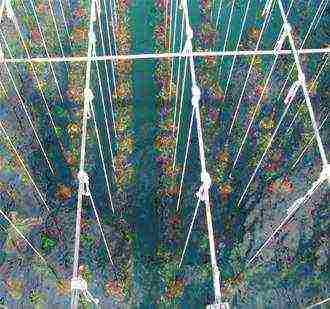
Collectors are installed a few weeks before the breeding periods of mussels (autumn, spring), so that they are covered with a bacterial film necessary for the best settling of mussel larvae.
In search of a place of settlement, mussel larvae settle on collectors, attach and live on them permanently. Mussels are very fertile, during the season one individual lays more than 10 thousand eggs, the larvae, having hatched from the eggs, swim freely and feed, reaching a size of 0.3 mm, choose a suitable place of residence and attach to it with byssus threads.
The mollusk feeds on its own throughout the period. The cultivation process requires underwater maintenance and cleaning of the substrates. In the process of increasing the weight of the mussels, so that the collector does not lose its buoyancy, it is periodically required to attach additional floats. For winter, to protect the collectors from storms and ice, the collectors are flooded to a greater depth with an additional load.
When the mussels reach a marketable size of 4 - 6 cm, the diver cuts off the leashes from the cargo, the collector with mussels floats, it is loaded onto a ship, where the mussels are beaten off and sent for processing.
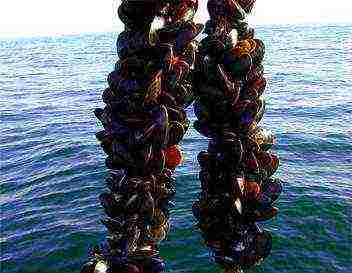
Mussels are grown for one or two years, two yearlings have a denser meat and a higher cost. If the farm is located in an area of insufficient water exchange, then the mussel during the spawning period can weaken and fall off the collector, and part of the harvest will be lost, therefore, only one-year-old mussels are grown on such farms.
Each running meter of the collector accommodates 13 - 15 kg of molluscs. The amount of meat from the total weight of shellfish is 12-15%.
To build a mussel farm, you will need to seek advice from a specialized institute, develop a biological justification and a mode of operation of the water area. It will also be necessary to develop the technical part for the construction of offshore structures.
Growing mussels is a business idea.
Currently, the development of the restaurant business has reached a very high level. With the development of the restaurant business, the demand for certain products that are used in the preparation of dishes also grows. And this article discusses mussels - one of the famous southern delicacies.
Growing mussel farms can no longer cope with the increasing demand for this commodity. About 12 million tons of mussels are produced annually around the world, therefore, mussel farming is an idea for your business.
Mussels are not some new delicacy. This product was known many thousands of years ago, but mainly among the southern peoples. It was and remains popular for its low calorie content and high protein and carbohydrate content.
Growing mussels does not cost much. One of the most basic is the installation of a special collector in the seawater. Every autumn and spring, many mussel larvae look for a place where they can attach and continue their existence. It can be breakwaters or rocks, or it can be a collector that the farmer has installed in advance. Collectors are usually installed at a distance of 5-6 meters from each other, and in the fall they are buried 5-10 meters so that the mussels do not suffer from the storm.
Mussels are removed from the collector using a mechanized line. First, the mussels are removed, then a special device separates the mollusks, and they enter the sorting drum.
Mussel growing systems are divided according to the method of water supply. These are flow systems, semi-flow and closed-loop. Growing mussels at home using a semi-flow system is considered the most rational in large-scale production.
If you want to grow your mussels at home, you need a closed-loop system. Its main advantage is that it is autonomous. The main disadvantage is the large amount of water consumed.
Also, when growing mussels, you can forget about food, because the mussel itself secretes food for itself from the water that enters it through a siphon.
France consumes 95% of live shellfish. For this country, this is a very common and familiar food product. That is why this country alone produces about 50 thousand tons of mussels per year.Only China is ahead of it - 600 thousand tons of mussels per year, since the content of mussel farms is not at all expensive and there are many of them along the coastline.
Cultivation of mussels is not labor-intensive process, and also does not require large investments, moreover, it has a quick payback. Entrepreneurs should pay attention to this market because the supply of farms is no longer able to meet the ever-growing demand.


